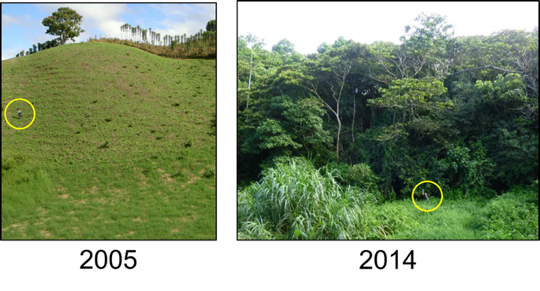Uneven Starting Points Complicate Comparisons of Outcomes Between Natural Regeneration and Active Forest Restoration
Reid, J. L., M. E. Fagan, and R. A. Zahawi. 2018. Positive site selection bias in meta-analyses Comparing natural regeneration to active forest restoration. Science Advances 4:eaas9143.
Imagine a tropical cow pasture. What is the best way to restore it to a forest? One way would be to plant native trees – an “active” approach. Another way would be to let it recover on its own – a more “passive” approach. Which is the better path?
This question is important because decisions about how to restore tropical forests have the potential to affect millions of hectares of land over the next ten years. Several recent studies compared the outcomes of active restoration and natural regeneration of tropical forests, and found, by and large, that letting forests regrow naturally was as good as or better than planting trees. But our review shows that the comparisons were uneven. The problem was that the set of studies looking at natural regeneration were not really the same as the set of studies looking at tree planting. Many of the natural regeneration studies focused on forests that already existed. On the other hand, tree planting studies focused on a wider range of sites, many of which started with no forest.
As a thought experiment, imagine a 10-year old, natural regeneration forest, with a closed canopy and many small trees. Now imagine a cow pasture, with no canopy cover or trees. If you plant trees on the cow pasture today and wait ten years, will it have the same canopy cover and tree density as the 10-year old forest? It might, but the trees also might not grow, if they are outcompeted by exotic grasses, for example. Thus, the tree plantation has the chance to fail, but the natural regeneration forest is already a forest. It would not be fair to compare the success of one to the other because the starting conditions are quite different.
Based on our review, we suggest that the best way to compare natural regeneration to tree planting is through paired experiments, where both strategies have an equal chance of failing or succeeding at the outset. However, even if one strategy is better more often than the other, we would still recommend that land managers consider combining elements of both strategies to design restoration practices for their own land. In particular, it may be helpful for practitioners to wait for a year or two and see how well forests recover naturally before investing in more expensive tree planting campaigns.
PARTNERS Connections
This open-access review paper was facilitated by the fact that we were already working together to study forest persistence – a subject that came to the forefront during the first PARTNERS meeting in Storrs in 2014. We happened to be talking to one another around the time when we were all reading the new studies comparing natural regeneration to tree planting. The paper was covered by several science news outlets (EurekAlert, UMBC News, ScienceDaily), and we also described it in a blog.

Side-by-side comparison of natural regeneration (foreground) and active tree planting (background) to restore a cattle pasture in southern Costa Rica. Tree seedlings planted on the hillside are just visible in the 2005 image. The yellow circle indicates a person for scale. After nine years, active tree planting had produced a forest, whereas natural regeneration was stalled. Overgrown pasture grasses covered the ground. Natural regeneration is highly variable, so this example is not representative of all situations. Photos by Karen Holl.



